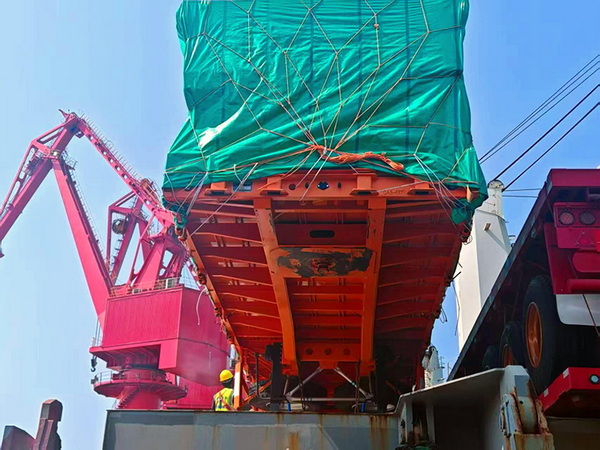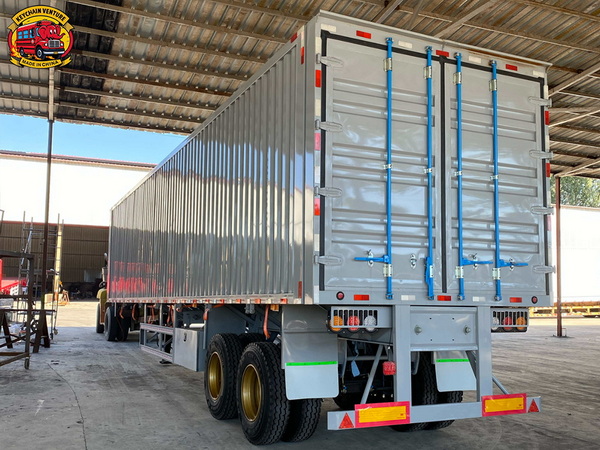Views: 222 Author: Amanda Publish Time: 2025-10-19 Origin: Site








Content Menu
● Understanding the Flatbed Semi Trailer
● Standard Lengths of Flatbed Semi Trailers
● Detailed Size Specifications
>> Length
>> Width
>> Height
● Common Types of Flatbed Semi Trailers
>> Lowboy
● Flatbed Semi Trailer Features
● Specifications by Popular Sizes
● How Length Affects the Semi Trailer's Usefulness
● Safety and Legal Considerations
● Industry Applications of Flatbed Semi Trailers
● FAQ
>> 1. What is the most common length of a flatbed semi trailer?
>> 2. Can flatbed semi trailers extend beyond 53 feet?
>> 3. What materials are used to build flatbed semi trailers?
>> 4. How many axles does a flatbed semi trailer have?
>> 5. What safety features are standard on flatbed semi trailers?
When it comes to transporting oversized, heavy, or irregular cargo, a flatbed semi trailer is one of the most versatile and commonly used solutions worldwide. But exactly how long is a flatbed semi trailer? This question is fundamental not only for logistics companies and drivers but also for clients planning cargo shipments. This article dives deep into the dimensions, specifications, types, and uses of flatbed semi trailers, helping you understand why the length and overall size matter for effective transportation.

A flatbed semi trailer is a type of trailer featuring an open, flat deck without walls or a roof. This fundamental design allows it to carry a wide variety of items such as large machinery, construction materials, vehicles, and even oversized containers. The absence of height restrictions common in enclosed trailers means flatbeds are ideal for loads taller than conventional trailers allow.
The length of flatbed semi trailers varies largely depending on local regulations, intended cargo, and manufacturer design. In general:
- The most common lengths fall between 48 to 53 feet (approximately 14.6 to 16.2 meters).
- Specialized extendable flatbeds can reach a length of up to 80 feet (24.4 meters) to haul extra-long items.
- Smaller flatbeds or specialty trailers like lowboys may range from 20 to 29 feet in length.
These length variations are designed to optimize cargo capacity while ensuring compliance with road safety regulations and weight restrictions.
- Standard flatbed trailers measure about 48 to 53 feet in length. This size accommodates a wide range of cargo types and fits most shipping and logistics needs.
- Extendable flatbeds can stretch from a base length of 48 feet up to 80 feet long to transport exceptionally long loads like steel pipes, beams, or construction equipment.
- Smaller flatbeds designed for lighter or more specialized loads might be 20, 40, or 45 feet long, also corresponding to standard container sizes.
- The standard legal width for flatbed semi trailers in many countries, including the U.S. and China, is 8.5 feet (102 inches). This width maximizes road safety while allowing for significant cargo width.
- Some jurisdictions allow slightly wider loads with special permits, but 8.5 feet remains the norm.
- Flatbed semi trailers generally have a deck height of around 5 feet (60 inches) from the ground.
- The maximum cargo height allowed by law, including trailer height, is usually about 13.5 to 14 feet, so loads exceeding this height require permits or specialized transportation methods.
The traditional flatbed with an open deck and no sides or roof. It usually comes in 48- to 53-foot lengths and is used for diverse freight.
This type offers an extendable deck that can lengthen up to 80 feet, perfect for long and awkward cargo.
Featuring two sections—the upper deck and a lower "step-down" deck—this trailer can carry taller items due to the lowered middle deck height.
A very low flatbed with a deck height between 18 to 24 inches, used to haul very tall or overweight machinery with a maximum cargo height up to 12 feet.
Flatbeds with curtain sides for better cargo protection while retaining loading/unloading flexibility.

- Heavy-Duty Frame: Constructed primarily from high-tensile steel (often Q345B carbon steel) or aluminum for weight savings.
- Durable Flooring: Usually checker steel plates or treated hardwood to resist impact and provide a non-slip surface.
- Axle Configurations: Usually 2 to 4 axles, from brands like BPW, FUWA, or SAF, supporting payloads from 20 to 80 tons.
- Lashing and Securing Equipment: Side stake pockets, lashing rings, rope hooks, and twist locks to keep cargo secure.
- Braking System: Often equipped with dual-line pneumatic brakes with ABS for maximum safety.
- Suspensions: Choice of mechanical leaf springs or air suspension to improve ride quality.
- Landing Gear and Kingpin: Manual or mechanical landing gear for stability when parked, with 2" or 3.5" kingpins compatible with tractor units.
- Lighting and Reflectors: Full LED lighting systems ensuring road legal compliance.
| Specification | 20ft Flatbed Semi Trailer | 40ft Flatbed Semi Trailer | 45ft Flatbed Semi Trailer | 53ft Flatbed Semi Trailer |
| Length (mm) | 7000 | 12400 | 13950 | 16000 (approx) |
| Width (mm) | 2500 | 2500 | 2500 | 2500 |
| Height (mm) | 1570 | 1570 | 1600 | 1600 (varies) |
| Axles | 2 or 3 | 2 or 3 | 2 or 3 | 2 to 4 |
| Payload Capacity (tons) | 20-60 | 30-80 | 30-80 | Up to 80+ |
| Material | Q345B steel | Q345B steel | Q345B steel | High-tensile steel |
| Weight (tons) | 7-9 | 7-9 | 9-12 | Varies |
Length directly impacts the load volume and types of cargo that can be transported. For example:
- Shorter flatbeds (20 to 40 feet) are suitable for smaller containers or machinery.
- Standard 48-53 foot flatbeds handle most palletized goods, construction materials, and irregular cargo.
- Extendable flatbeds (up to 80 feet) enable the movement of very long products like steel beams, large pipes, or wall panels.
Longer trailers require careful legal adherence with respect to road limits and permits. Also, maneuverability and storage considerations come into play, especially in urban environments.
- In the U.S., the Federal Highway Administration generally limits trailer length to 53 feet without special permits.
- Width is typically limited to 8.5 feet unless a special permit allows wider loads.
- Over-length or over-width cargo usually requires pilot vehicles and additional safety measures.
- Regulations differ country to country; operators should consult local laws for transport compliance.
Flatbed semi trailers serve industries including:
- Construction (transporting beams, concrete sections, machinery)
- Manufacturing (large item shipments)
- Agriculture (farm equipment)
- Shipping and Logistics (containers, oversized loads)
- Timber and Paper (logs, large rolls of paper)
Their open accessibility and versatility make them an essential vehicle in supply chains internationally.
The length of a flatbed semi trailer is not fixed but ranges from 20 feet for smaller models up to 80 feet for specialized extendable variants. The most common length remains between 48 and 53 feet, balancing capacity and regulatory compliance. With their open, flat deck design, flatbed semi trailers provide unmatched flexibility for hauling oversized and heavy loads across multiple industries. Understanding the specific length requirements and trailer features based on your cargo type is crucial for optimizing transportation efficiency and safety.

The most common length for flatbed semi trailers is between 48 to 53 feet, which suits most general freight needs and legal regulations.[3][7]
Yes, certain extendable flatbed trailers can reach lengths of up to 80 feet for carrying extra-long cargo.[3]
They are primarily built with high-tensile steel such as Q345B or aluminum alloys for durability and reduced weight.[4][7]
Flatbed semi trailers typically have between 2 and 4 axles, depending on load capacity and trailer size.[4]
Standard safety features include dual-line pneumatic brakes with ABS, multiple lashing rings, stake pockets, LED lighting, and stable landing gear.[4]
[1](https://streamlogistics.com/trailer-dimensions/)
[2](https://www.dsv.com/en/our-solutions/modes-of-transport/road-transport/trailer-sizes/open-trailer)
[3](https://www.lytx.com/blog/flatbed-truck-and-trailer-guide-dimensions-restrictions-and-more)
[4](https://www.pandamech.com/info/what-is-a-flatbed-semi-trailer/)
[5](https://brucerockengineering.com.au/wp-content/uploads/Australian-Steel-Flatbed-DATA-SHEET.pdf)
[6](https://www.cnhtcgroup.com/trucks/sinotruck-flatbed-semi-trailer-truck/)
[7](https://sunightmachinery.com/trailer/flatbed-semi-trailer.php)
[8](https://www.utilitytrailer.com/flatbeds/specifications/)
[9](https://www.howo-truck.com/trucks/sinotruck-flatbed-semi-trailer-truck/)
[10](https://www.sinotruks.biz/vehicles/semi_trailer/68.html)